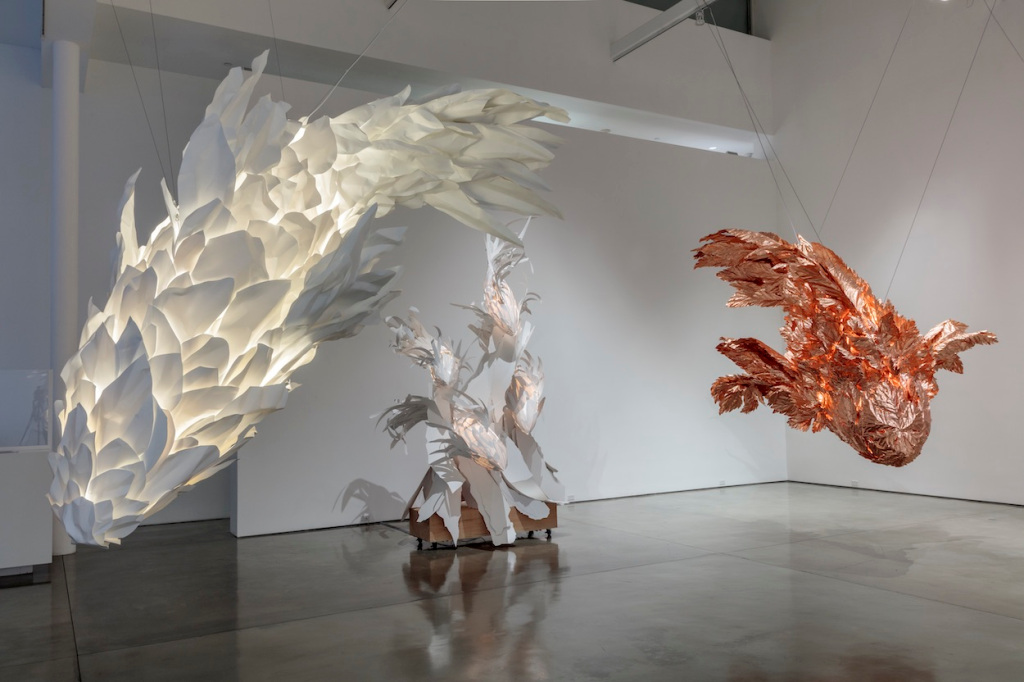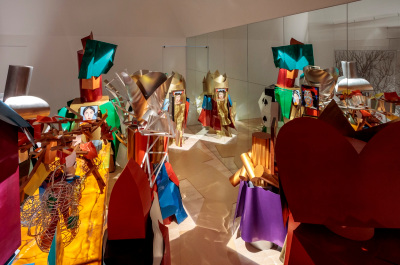 View of “Frank Gehry: Spinning Tales,” 2021, at Gagosian. Photo: Joshua White. © Frank O. Gehry. Courtesy Gagosian.
View of “Frank Gehry: Spinning Tales,” 2021, at Gagosian. Photo: Joshua White. © Frank O. Gehry. Courtesy Gagosian.
Frank Gehry says he aimed to capture the brushstroke effect of Vincent van Gogh’s Starry Night in his latest building, making his tower for the Luma Foundation in Arles, France one of many examples of his corny artistic ambitions. Inklings of these are evident even in his sketches—impassioned, nearly illegible scribbles more likely to be exhibited in a museum than referenced by a contractor or client. Gehry is famous for privileging form over function, often to the point of controversy. In Cleveland and in Cambridge, his unconventional roof shapes have produced dangerous avalanches on snowy days. And his sinuous museums have been accused of upstaging the artworks they’re meant to show—to which Gehry’s friend Julian Schnabel has retorted, “Maybe that art isn’t good enough.”
In one of several origin stories Gehry has offered—and also disavowed—he traces his obsession with undulating forms back to a formative childhood memory, when his grandmother would take him to the market to buy a carp and little Frank would play with the fish in the bathtub until it was time to cook it. His “Fish Lamps”—sculptural, scaly light fixtures begun in 1983—decorate the first floor of his show at Gagosian in Beverly Hills, on view through August 6. The series began with a commission from Formica, a laminate company, intended to showcase the wide-ranging uses of its product. After the accidental breakage of a Formica sheet produced a rough edge, Gehry noticed the material could easily be made into scales. Soon, the quirky little lamps became collectors’ items, purchased by the likes of Philip Johnson and Jasper Johns. They haven’t changed much since, aside from growing a bit bigger and curvier, even though Gehry has been making them for nearly forty years, and this is his seventh “Fish Lamps” show at Gagosian. I suppose they haven’t needed to evolve: after all, they’re derived from deep within the psyche of one of our era’s great creative geniuses.
 Frank Gehry, Wishful Thinking (detail), 2021, eleven individual sculptures in aluminum, automotive paint, acrylic, stainless steel, brass, and teak; orange onyx and aluminum table with LED lights; three stainless-steel wire tapestries, overall dimensions 156 by 372 by 246 in. Photo: Joshua White. © Frank O. Gehry. Courtesy Gagosian.
Frank Gehry, Wishful Thinking (detail), 2021, eleven individual sculptures in aluminum, automotive paint, acrylic, stainless steel, brass, and teak; orange onyx and aluminum table with LED lights; three stainless-steel wire tapestries, overall dimensions 156 by 372 by 246 in. Photo: Joshua White. © Frank O. Gehry. Courtesy Gagosian.
Gehry’s vaguely psychoanalytic origin story is a tad self-serious. Yet the immersive installation in Gagosian’s upstairs gallery, Wishful Thinking (2021)—a re-creation of the Mad Hatter’s tea party from Alice’s Adventures in Wonderland in brightly painted metals—is so unbelievably twee that it throws into question whether or not Gehry takes himself seriously at all. For the most part, it cobbles together his regular forms, but with the occasional three-foot-tall playing card or oversize wire teacup, and several frighteningly rendered paintings of Lewis Carroll’s characters, like the Queen of Hearts. Much like Gehry’s explanations for his interest in fish, the work is a reminder that Gehry’s content and messages are often shoehorned into his formal interests, particularly when he attempts to frame them as art. It’s tempting to read these efforts as searing caricatures of the art of our times—especially given the installation’s floor-to-ceiling mirror that practically begs visitors to take a selfie. But more likely, they’re uncritical regurgitations that Gehry (or his PR team) hopes will elevate his work beyond mere design. Wishful Thinking looks straight out of the 1980s, though it also has an air of the “Kusama effect”—which Gehry seems to acknowledge has superseded his own “Bilbao effect” in terms of drawing crowds or drumming up press.
Gehry’s out-of-touch ideas about art are almost endearing, but they aren’t exactly harmless—and not just because his buildings have come dangerously close to inflicting injuries. About 170 people work for the architect, turning his highfalutin doodles into something that will actually stand up. It’s easy to imagine his workshop resembling not an artist’s studio, where fabricators might execute their boss’s conceptual commentary or detailed drawings, but a multimillion-dollar business producing branded products. He is, after all, running a firm—though the practice of attributing architecture to just one man (as, tellingly, artists are known to do with their work) is waning. The postmodern architects of Gehry’s generation embraced vacuity and ambiguity, surface and facade, and his contribution involved infusing more whimsy into a discipline still largely defined by boring concrete modernist grids. But framing something as art involves begging viewers to look deeper, and in the gallery, Gehry’s ideas translate into works that are literally and figuratively hollow.
Source link : https://www.artnews.com/art-in-america/aia-reviews/frank-gehry-gagosian-beverly-hills-fish-lamps-1234600143












